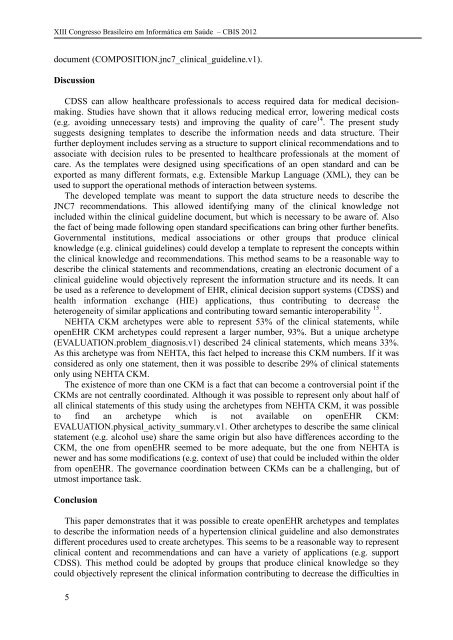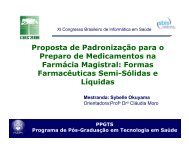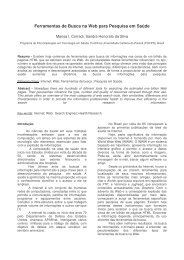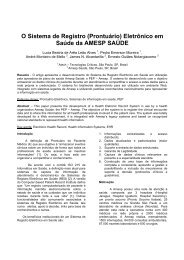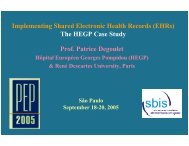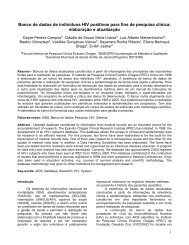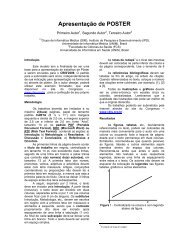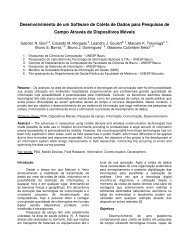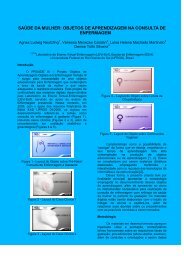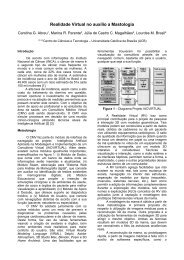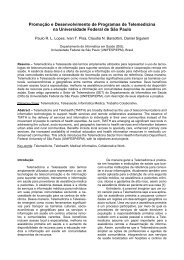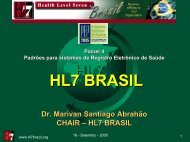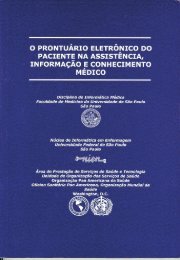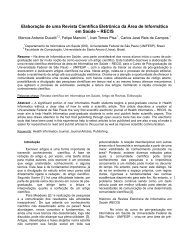from clinical guideline to openehr: converting jnc7 into archetypes ...
from clinical guideline to openehr: converting jnc7 into archetypes ...
from clinical guideline to openehr: converting jnc7 into archetypes ...
You also want an ePaper? Increase the reach of your titles
YUMPU automatically turns print PDFs into web optimized ePapers that Google loves.
XIII Congresso Brasileiro em Informática em Saúde – CBIS 2012document (COMPOSITION.<strong>jnc7</strong>_<strong>clinical</strong>_<strong>guideline</strong>.v1).DiscussionCDSS can allow healthcare professionals <strong>to</strong> access required data for medical decisionmaking.Studies have shown that it allows reducing medical error, lowering medical costs(e.g. avoiding unnecessary tests) and improving the quality of care 14 . The present studysuggests designing templates <strong>to</strong> describe the information needs and data structure. Theirfurther deployment includes serving as a structure <strong>to</strong> support <strong>clinical</strong> recommendations and <strong>to</strong>associate with decision rules <strong>to</strong> be presented <strong>to</strong> healthcare professionals at the moment ofcare. As the templates were designed using specifications of an open standard and can beexported as many different formats, e.g. Extensible Markup Language (XML), they can beused <strong>to</strong> support the operational methods of interaction between systems.The developed template was meant <strong>to</strong> support the data structure needs <strong>to</strong> describe theJNC7 recommendations. This allowed identifying many of the <strong>clinical</strong> knowledge notincluded within the <strong>clinical</strong> <strong>guideline</strong> document, but which is necessary <strong>to</strong> be aware of. Alsothe fact of being made following open standard specifications can bring other further benefits.Governmental institutions, medical associations or other groups that produce <strong>clinical</strong>knowledge (e.g. <strong>clinical</strong> <strong>guideline</strong>s) could develop a template <strong>to</strong> represent the concepts withinthe <strong>clinical</strong> knowledge and recommendations. This method seams <strong>to</strong> be a reasonable way <strong>to</strong>describe the <strong>clinical</strong> statements and recommendations, creating an electronic document of a<strong>clinical</strong> <strong>guideline</strong> would objectively represent the information structure and its needs. It canbe used as a reference <strong>to</strong> development of EHR, <strong>clinical</strong> decision support systems (CDSS) andhealth information exchange (HIE) applications, thus contributing <strong>to</strong> decrease theheterogeneity of similar applications and contributing <strong>to</strong>ward semantic interoperability 15 .NEHTA CKM <strong>archetypes</strong> were able <strong>to</strong> represent 53% of the <strong>clinical</strong> statements, whileopenEHR CKM <strong>archetypes</strong> could represent a larger number, 93%. But a unique archetype(EVALUATION.problem_diagnosis.v1) described 24 <strong>clinical</strong> statements, which means 33%.As this archetype was <strong>from</strong> NEHTA, this fact helped <strong>to</strong> increase this CKM numbers. If it wasconsidered as only one statement, then it was possible <strong>to</strong> describe 29% of <strong>clinical</strong> statementsonly using NEHTA CKM.The existence of more than one CKM is a fact that can become a controversial point if theCKMs are not centrally coordinated. Although it was possible <strong>to</strong> represent only about half ofall <strong>clinical</strong> statements of this study using the <strong>archetypes</strong> <strong>from</strong> NEHTA CKM, it was possible<strong>to</strong> find an archetype which is not available on openEHR CKM:EVALUATION.physical_activity_summary.v1. Other <strong>archetypes</strong> <strong>to</strong> describe the same <strong>clinical</strong>statement (e.g. alcohol use) share the same origin but also have differences according <strong>to</strong> theCKM, the one <strong>from</strong> openEHR seemed <strong>to</strong> be more adequate, but the one <strong>from</strong> NEHTA isnewer and has some modifications (e.g. context of use) that could be included within the older<strong>from</strong> openEHR. The governance coordination between CKMs can be a challenging, but ofutmost importance task.ConclusionThis paper demonstrates that it was possible <strong>to</strong> create openEHR <strong>archetypes</strong> and templates<strong>to</strong> describe the information needs of a hypertension <strong>clinical</strong> <strong>guideline</strong> and also demonstratesdifferent procedures used <strong>to</strong> create <strong>archetypes</strong>. This seems <strong>to</strong> be a reasonable way <strong>to</strong> represent<strong>clinical</strong> content and recommendations and can have a variety of applications (e.g. supportCDSS). This method could be adopted by groups that produce <strong>clinical</strong> knowledge so theycould objectively represent the <strong>clinical</strong> information contributing <strong>to</strong> decrease the difficulties in5


